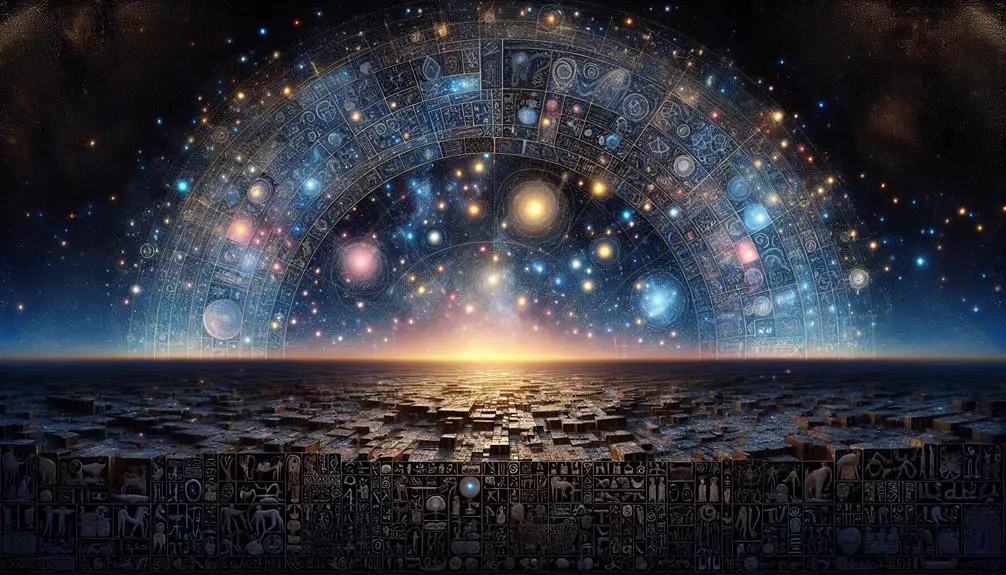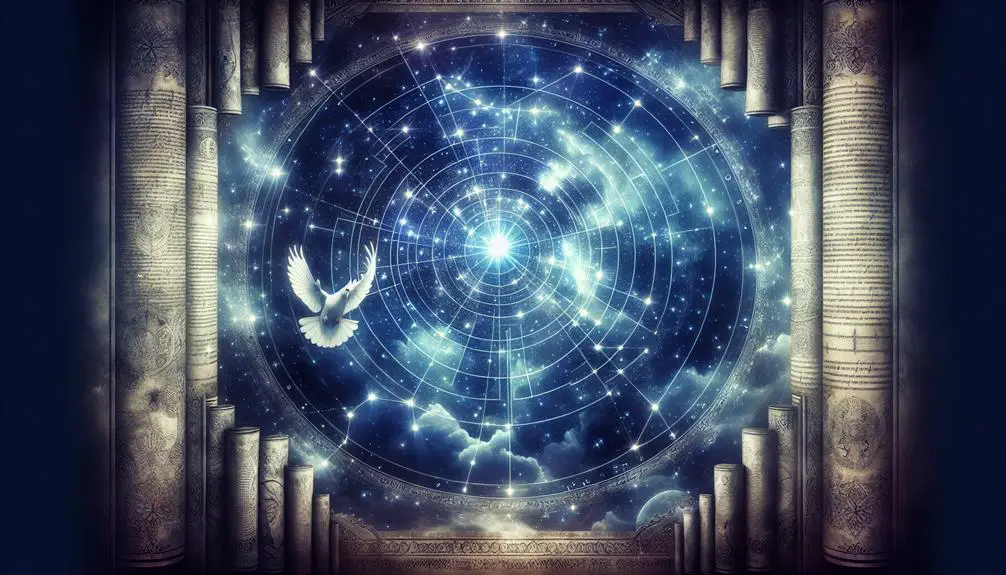Witness the celestial mystery of Pleiades and Orion in the Bible, where stars illuminate ancient wisdom and untold stories beckon.

Pleiades and Orion in the Bible
The Pleiades and Orion, two prominent celestial entities, hold a captivating presence not only in the night sky but also within the ancient texts of the Bible. These constellations, mentioned in the books of Job and Amos, serve as more than mere astronomical phenomena; they embody profound symbolism and are woven into the fabric of biblical narratives, offering insights into the historical, cultural, and theological perspectives of the times.
As we explore these references and their implications, one might find themselves intrigued by the depth and breadth of meaning these celestial bodies have carried through millennia, prompting a further examination of their significance in both ancient and contemporary contexts.
Key Takeaways
- Pleiades and Orion symbolize divine wisdom and the limits of human understanding in biblical narratives.
- Their appearances in Job and Amos highlight God's omnipotence and the meticulous design of the universe.
- These constellations represent themes of unity, strength, and divine guidance in biblical literature.
- Biblical references to Pleiades and Orion enrich theological discussions and invite reflection on the cosmos.
Biblical References Explained

In the context of biblical literature, references to the Pleiades and Orion carry significant symbolic and prophetic implications, warranting an in-depth analytical exploration of their appearances within the scriptures. These celestial bodies are not merely mentioned for their astronomical significance but are imbued with deep theological meaning, reflecting the ancient Hebrews' understanding of the cosmos as intertwined with divine providence. Star naming in biblical texts is not an arbitrary practice but a deliberate theological act, signifying God's sovereignty over creation and humanity's place within it.
The mention of Pleiades and Orion can be found in the Old Testament, most notably in the book of Job and the book of Amos. These references are not merely observational but are charged with prophetic alignments, suggesting a cosmic order that underscores God's omnipotence and omniscience. In Job 38:31, God challenges Job by questioning his ability to 'bind the chains of the Pleiades' or 'loosen Orion's belt,' using these constellations as metaphors for the limits of human understanding and the vastness of divine wisdom.
Similarly, Amos 5:8 extols God as He who 'turns deep darkness into the morning and darkens the day into night,' who calls 'for the waters of the sea and pours them out over the surface of the earth,' and is named alongside the creator of the Pleiades and Orion. These passages underscore a profound recognition of a divinely ordained cosmic order, where star naming and prophetic alignments serve as testimonies to God's unassailable power and the meticulous design of the universe, emphasizing the meticulous interplay between the celestial and the divine within biblical tradition.
Symbolism and Significance

The subtopic of 'Symbolism and Significance' within the context of Pleiades and Orion in the Bible transitions from mere textual references to a deeper analysis of their metaphorical and astronomical implications. By decoding biblical references, this section aims to illuminate the intricate relationship between these celestial bodies and their theological interpretations.
Furthermore, exploring astronomical connections provides a broader understanding of how these constellations have been perceived and integrated into biblical narratives across time.
Biblical References Decoded
Biblical references to the Pleiades and Orion carry profound symbolic significance, reflecting the ancient understanding of the cosmos and its relation to divine intervention and human destiny. These celestial entities were not just marvels of the night sky but were deeply embedded in the cultural fabric, influencing both star naming and constellation mythologizing.
Constellation |
Symbolic Significance |
|---|---|
Pleiades |
Representing unity and the divine guidance, the Pleiades are often seen as a symbol of brotherhood and the interconnectedness of creation. |
Orion |
Symbolizing strength and the struggles of humanity, Orion's portrayal in the Bible mirrors the challenges faced by individuals and the hope of divine assistance. |
This decoding of biblical references underscores the rich tapestry of symbolism, where celestial phenomena are interwoven with human experiences and theological concepts.
Astronomical Connections Explored
Exploring the astronomical connections between the Pleiades and Orion sheds light on their deep symbolic significance within the biblical narrative, revealing a complex interplay between celestial phenomena and theological themes. The intricate dynamics of star naming and constellation myths contribute rich layers of meaning to these references:
- Star naming practices illuminate the ancient understanding of divine order.
- Constellation myths offer insights into the cultural and spiritual values of the time.
- The Pleiades and Orion symbolize themes of guidance, judgment, and redemption.
- Their appearances in different seasons underscore the cyclical nature of life and faith.
- The juxtaposition of these constellations highlights the tension between chaos and cosmos.
This analysis underscores the profound connections between the heavens and the sacred texts, enriching our understanding of biblical symbolism.
Historical Context

Ancient civilizations, deeply intertwined with the cosmos, often referenced celestial bodies such as the Pleiades and Orion, imbuing them with significant cultural and religious meanings. Their appearances and positions in the sky were not only markers of time but also bore geographical implications, influencing navigation, agriculture, and the delineation of territories. The Pleiades and Orion, specifically mentioned in the Bible, serve as a testament to their enduring legacy across cultures and epochs. These celestial entities were perceived as divine or semi-divine figures, their stories woven into the fabric of mythologies and religious texts, illustrating the human quest to understand the universe.
The chronological debates surrounding these references in biblical texts highlight the complex relationship between astronomy and theology. Scholars scrutinize these mentions to discern the historical context of biblical passages, attempting to align astronomical phenomena with historical events. This pursuit involves intricate calculations and interpretations, aimed at understanding how ancient peoples conceptualized and utilized their knowledge of the stars. The mention of Pleiades and Orion in the Bible thus opens a window into the past, offering insights into how these constellations were perceived and their significance in the biblical narrative.
Exploring the historical context of Pleiades and Orion in the Bible necessitates a multidisciplinary approach, intersecting the fields of astronomy, theology, history, and archaeology. Such an analysis reveals the depth of human engagement with the cosmos, reflecting the enduring fascination with celestial phenomena and their impact on human civilization.
Astronomical Insights

Delving into the astronomical insights provided by references to Pleiades and Orion in the Bible offers a nuanced understanding of these constellations' roles within the fabric of ancient observational astronomy. The biblical mentions not only underscore the cultural significance of these celestial bodies but also highlight the advanced knowledge of the night sky that ancient observers possessed. This understanding was crucial for a variety of practical purposes, including the timing of agricultural cycles and celestial navigation.
The astronomical significance of Pleiades and Orion can be discerned through several key factors:
- Star Clusters: Both Pleiades and Orion are prominent star clusters that are visible to the naked eye. Their distinct formations have made them easily recognizable landmarks in the night sky throughout human history.
- Celestial Navigation: These constellations served as vital reference points for ancient mariners navigating the vast oceans. Their positions helped in determining direction and gauging the time of year, essential for safe and successful voyages.
- Seasonal Markers: The rising and setting of Pleiades and Orion were closely observed by ancient cultures, often associated with the onset of significant seasonal changes critical for agricultural practices.
- Astronomical Precision: The references to these constellations in the Bible reflect a keen observational precision, indicating a sophisticated understanding of the movements and cycles of celestial bodies.
- Historical Astronomy: The biblical mentions of Pleiades and Orion contribute valuable insights into the early development of astronomy, showcasing how ancient peoples integrated astronomical observations into their daily lives and spiritual beliefs.
This exploration offers a window into the rich tapestry of ancient astronomical knowledge and its integration into early human civilization's cultural and practical domains.
Cultural Interpretations

The exploration of cultural interpretations surrounding Pleiades and Orion necessitates a critical analysis of ancient texts. These constellations are embedded with rich symbolic meanings.
This inquiry extends into the realm of modern symbolic significance, where these celestial bodies continue to influence contemporary cultural narratives and identities.
An analytical approach enables a comprehensive understanding of how these astral symbols have traversed cultural and historical landscapes, shaping and being shaped by human societies across time.
Ancient Texts Analysis
Exploring the cultural interpretations of the Pleiades and Orion within ancient texts reveals a rich tapestry of cosmological significance and mythological narratives that have influenced societies throughout history. These constellations' appearances in sacred and historical documents underscore their importance, but the journey to understand their roles and meanings is complicated by textual discrepancies and translation challenges.
- Textual Discrepancies: Variations in ancient manuscripts may lead to differing interpretations.
- Translation Challenges: The original language's nuances can be lost or altered.
- Mythological Significance: Stories surrounding these constellations offer insights into ancient beliefs.
- Cosmological Importance: Their positions and movements were used to mark time and seasons.
- Cultural Influence: These celestial bodies have shaped rituals, calendars, and agricultural practices.
Analyzing these aspects provides a deeper understanding of the Pleiades and Orion's roles in ancient cultures.
Modern Symbolic Significance
Having examined the historical and mythological contexts of the Pleiades and Orion, it is imperative to consider their modern symbolic significance across various cultures. These constellations continue to inspire artistic influences, bridging ancient narratives with contemporary expressions in visual arts, literature, and music.
This amalgamation enriches our cultural tapestry, allowing for a multifaceted exploration of celestial themes. Moreover, psychological interpretations of Pleiades and Orion have emerged, reflecting the human inclination towards finding meaning in the stars. These interpretations often delve into the collective unconscious, suggesting that these constellations serve as archetypal symbols that resonate across different societies.
This dual influence—artistic and psychological—highlights the enduring legacy of Pleiades and Orion in shaping human thought and creativity.
Theological Implications

Analyzing the references to Pleiades and Orion within biblical texts reveals profound theological implications, particularly in understanding the nature of God's creation and humanity's place within it. These constellations, mentioned notably in the books of Job and Amos, serve not only as celestial markers but also as symbols of divine creativity and moral lessons. Their inclusion in sacred scripture highlights several key aspects of theological discourse:
- Divine Creativity: The majestic descriptions of Pleiades and Orion in the Bible underscore the limitless creativity of God. They remind readers of the awe-inspiring complexity and beauty of the universe that is often beyond human comprehension.
- Moral Lessons: Through these constellations, the biblical text conveys lessons about humility and the importance of recognizing one's place in the grand scheme of creation. They serve as metaphors for the intricate order and balance established by God, against which human pride and arrogance are contrasted.
- God's Sovereignty: The references to these star clusters illustrate God's absolute power over the cosmos. They affirm that everything in the universe is under His control, including the seemingly unchangeable stars.
- Humanity's Place: These passages highlight the smallness of humanity in comparison to the vastness of the cosmos, prompting reflection on human significance and dependence on divine grace.
- Invitation to Wonder: Finally, the mention of Pleiades and Orion invites believers and readers alike to marvel at the mysteries of the universe, encouraging a sense of wonder and curiosity about the world God has made.
Through these lenses, the biblical mentions of Pleiades and Orion contribute to a richer understanding of theological themes, weaving together observations of the natural world with insights into the character of God and the human condition.
Modern Relevance

In today's rapidly evolving world, the biblical references to Pleiades and Orion hold enduring relevance, offering insights into contemporary issues of spirituality and humanity's relationship with the cosmos. These ancient constellations, woven into the fabric of Scripture, serve as metaphors for the immutable laws governing the universe and our quest for spiritual understanding within it. As humanity progresses, the dialogue between science and spirituality grows more intertwined, with these celestial bodies symbolizing the bridge between the two realms. This interconnection underpins many contemporary debates, particularly those surrounding the reconciliation of faith with scientific discovery.
The mention of Pleiades and Orion in the Bible also invites a deeper exploration of spiritual practices in the modern context. These constellations, representing order and beauty in the heavens, encourage a reflection on the harmony and intricacy of creation. They echo the biblical theme of the cosmos as a testament to divine craftsmanship, prompting individuals to seek a connection with the creator through the majesty of creation. In this way, Pleiades and Orion transcend their historical and cultural origins, becoming symbols for the universal human experience of awe and wonder in the face of the vast, star-studded sky.
This connection has profound implications for contemporary spiritual practices. It encourages a holistic view of spirituality that embraces the natural world and its mysteries. In the modern quest for meaning, Pleiades and Orion serve as reminders of our smallness in the cosmos and the importance of maintaining a humble posture before the mysteries of the universe. As such, they continue to inspire both awe and spiritual reflection, bridging the gap between ancient texts and the frontiers of human understanding.
Frequently Asked Questions
How Do Different Translations of the Bible Impact the Depiction of Pleiades and Orion?
Different translations of religious texts, through varying translation methodology and linguistic evolution, can significantly alter the depiction of specific elements. This principle applies broadly, including to the portrayal of celestial bodies.
An analytical examination reveals that shifts in language and scholarly interpretations influence the readers' understanding and the contextual richness of these elements. Consequently, studying these variations offers insights into the dynamic interplay between language, culture, and religious narratives.
Are There Any Lost or Apocryphal Texts That Mention Pleiades and Orion Not Typically Included in Standard Biblical Canon?
Exploring the tapestry of ancient texts reveals that certain celestial narratives, particularly those involving the Pleiades and Orion, extend beyond the mainstream biblical anthology. These astral entities, rich in symbolism within modern astronomy and cultural interpretations, find echoes in apocryphal scriptures and lost writings.
An analytical examination suggests that these texts offer alternative insights, enriching our understanding of these constellations' significance in ancient cosmology and their enduring influence across diverse cultural landscapes.
How Have Artistic Representations of Pleiades and Orion Influenced or Been Influenced by Biblical Narratives?
Artistic representations of Pleiades and Orion have been profoundly shaped by, and have in turn shaped, modern interpretations and cultural symbolism. These celestial motifs, when analyzed in a scholarly and contextual manner, reveal a rich interplay between visual arts and narrative traditions.
This dynamic relationship underscores the influence of biblical narratives on artistic expressions, while also highlighting how such representations contribute to the evolving understanding and appreciation of these ancient texts within contemporary cultural discourse.
In What Ways Have Pleiades and Orion Been Referenced or Alluded to in Religious Rituals or Ceremonies Outside of the Biblical Text?
The referencing of Pleiades and Orion in religious rituals and ceremonies extends beyond biblical texts, embedding deeply in various cultural myths and star festivals. This phenomenon underscores the constellations' symbolic significance across civilizations.
Analytically, these celestial references serve as cultural touchstones, guiding agricultural activities, marking seasonal changes, and influencing spiritual practices. Their integration into rituals reflects a universal human tendency to seek meaning and order in the cosmos through the veneration of these star clusters.
Can the Mention of Pleiades and Orion in the Bible Be Linked to Specific Astronomical Events or Phenomena Observed in Ancient Times?
The inquiry into whether references to celestial bodies, specifically the Pleiades and Orion, correlate with observed astronomical events or phenomena in antiquity, involves examining star myths and cultural interpretations.
Analyzing these constellations within ancient texts reveals a nuanced understanding of their significance across different civilizations.
Such exploration offers insights into how these star clusters were not only observed but imbued with specific meanings, reflecting broader human attempts to interpret and codify the cosmos.
Conclusion
In conclusion, the Pleiades and Orion, as referenced in the Bible, offer a rich tapestry of meaning that transcends their astronomical significance. These constellations serve as cultural, theological, and historical touchstones that illuminate ancient worldviews and underscore the interconnectedness of the cosmos and spirituality.
By examining these celestial bodies in a biblical context, one gains insight into the ancients' attempt to read the night sky not just as a cosmic calendar, but as a divine narrative. In essence, unlocking the secrets of Pleiades and Orion is akin to finding a needle in a haystack, revealing the profound depth and complexity of biblical symbolism and its enduring relevance in the modern era.



Sign up